AMD Ryzen 5 2400G and Ryzen 3 2200G Integrated Graphics Frequency Scaling
by Gavin Bonshor on September 28, 2018 12:30 PM EST- Posted in
- CPUs
- AMD
- GPUs
- Overclocking
- Zen
- APU
- Vega
- Ryzen
- Ryzen 3 2200G
- Ryzen 5 2400G
Ryzen APU Integrated Graphics Scaling
Our of our promised Ryzen APU scaling articles, overclocking the integrated graphics was the most requested. Given that the Ryzen 5 2400G and Ryzen 3 2200G are marketed towards gamers on a budget, the gaming performance is perhaps the most important aspect to most users looking to purchase one for their system.
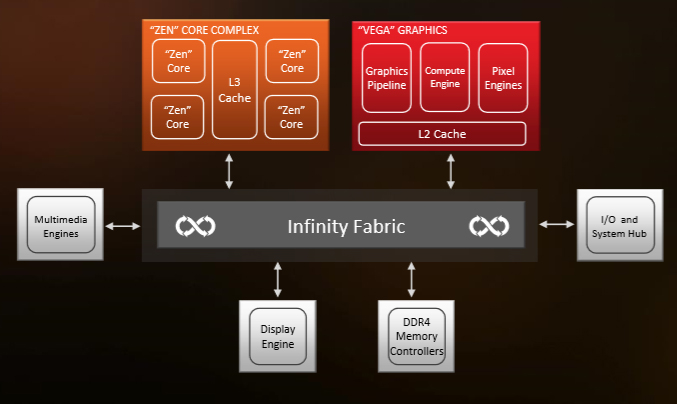
The Raven Ridge APU layout Highlighting the Infinity Fabric Interconnect
We have seen that the Infinity Fabric interconnect used within the SoC benefits from the use of faster memory in our Ryzen APU memory frequency scaling testing - because the Infinity Fabric and memory speed are directly linked, the CPU cores and GPU cores can communicate between the different areas faster. When overclocking a system for more performance, it all comes down to identifying the bottlenecks. Multiple bottlenecks can be in play at once, such as CPU frequency, GPU frequency, memory speed, and interconnect speed. As our set of articles on APU scaling have progressed, the final one left to analyze was GPU frequency. Hence, this review.
Scaling the APU, One Step (50 MHz) at a Time
For our overall analysis, we are splitting the data into two sets.
First up is the performance difference when simply overclocking the integrated graphics. Stepping up the frequency, as shown on the previous pages, usually increases performance, but here we will tell you how much in all four key areas: 2400G frames per second and percentile results, as well as 2200G frames per second and percentile results.
The second is to compare maximums. We have data now with the maximum tested integrated graphics frequency (1600 MHz) and the maximum tested CPU core frequency (3.9 GHz). The question becomes how much of a difference does overclocking one over the other make for gaming. The answer would normally sound obvious, but this is something we want to quantify. If a gamer has a choice between overclocking the CPU or the GPU, what should the target be, and how much should they expect? This data answers that question.
Group 1: 1600 MHz vs Stock
When comparing the results with the Ryzen 2000 series APUs at their stock settings against an overclock of 1600 MHz yields some good results across the majority of the titles tested in our testing suite.
Starting with the average frame rates, the Ryzen 3 2200G showed the biggest gains across the board, with the biggest benefits of overclocking in more graphically intensive games such as Total War: Warhammer 2 and Rise of the Tomb Raider. The 2400G, with its 28% overclock, pushed above 10% in Warhammer 2 and F1 2017, looks like it did not gain as much as the 2200G, but this is due to the lower percentage gain over the stock performance.
Focusing specifically on the 99th percentiles from the testing, the results given were erratic to say the least. All test results were repeatable across operating system reinstalls, but the 2400G showed regression in Shadow of Mordor and Warhammer 2. By contrast, the 2200G saw gains in both of those titles, a minimum of 8% across the board, and several titles scored around a 30% gain. For a 45% overclock, this is pretty good.
Group 2: What is Better, CPU OC or IGP OC?
In this set of results, we compare the uplift gained from a full GPU overclock to a full CPU overclock. This is to show which component of the chip provides the biggest benefit to frame rate performance in games: CPU or graphics. While increasing the CPU frequency is beneficial in improving performance in computationally dependent tasks such as video encoding, rendering and compression tasks, games should enjoy the graphics much more.
In our 2400G results, the winner between the two is clearly the integrated graphics. The CPU data shuffles around the same frame rates, not offering much benefit, while overclocking the GPU gives at least 5% extra frame rates across the board.
As the 2200G starts off from such a low point, overclocking both the CPU and GPU gets extra performance in almost every title. However, only overclocking the integrated graphics gets a good 10% gain across the board as a minimum, but more like 24%+ on games like F1 2017, Rise of the Tomb Raider, and Warhammer 2.
So while the analysis here is perhaps not as long-winded as our memory scaling and core frequency scaling pieces, the crux is that the integrated graphics is the key factor in gaming performance and despite the Infinity Fabric Interconnect combined with faster memory displaying a positive showing in our Ryzen 2000 series memory scaling analysis, the integrated graphics does offer more from a gamers standpoint. Of course, combining faster memory on top of an already overclocked Ryzen 2000 series iGPU is going to be the golden crown.
The Ryzen APUs; iGPU vs Core Frequency Plus Memory Frequency
When we took a look at how CPU Core Frequency Scaling with the Ryzen 5 2400G and Ryzen 3 2200G, we saw that the majority of the benefits came in compute heavy related tasks, and even gaining a distinct advantage when gaming with a discrete GPU. The gaming performance by just overclocking the CPU core frequency didn’t yield the results expected when using integrated graphics. In our dive into Memory Scaling on Zen and Vega, the consensus was that memory has a much greater effect on gaming performance than CPU frequency, as well as memory reliant applications and programs. Now while the focus has been purely on gaming this time around, which is to be expected given the target market AMD has aimed the Ryzen APUs firmly at, the results in some cases made a large difference in average frame rates; 99th percentiles on the whole did improve as the integrated graphics frequency went up, but some of the results were a little erratic, sometimes surpassing the overclock percentage jump.
For gaming, the extra performance gained in relation to the increase in graphics frequency is absolutely paramount in situations where average frame rate sits just below a key metric such as 720p60 or 1080p30. Gaming at 1080p60 is a little too much of a stretch for the integrated Vega cores, unless the game engine is less complex such as with titles such as MOBAs like DOTA 2, League of Legends and more recently, games like Fortnite being fine for this mixture of resolution and frame rate. As we found out in our Ryzen APU Overclocking Guide and Results article, the Ryzen APUs tend to prefer either high CPU frequencies or higher integrated graphics frequencies, but not both at the same time.
This means that users can choose which element of performance they want to improve, if the system is for compute related tasks or gaming. For any compute related workloads, the integrated graphics frequency is ineffective whereas pure MHz on the Ryzen cores and memory frequency can play a major part in improving performance throughput.
| Recommended Reading on AMD Ryzen APUs | |||
| 2400G Review | 2200G Review | Overclocking | Delidding |
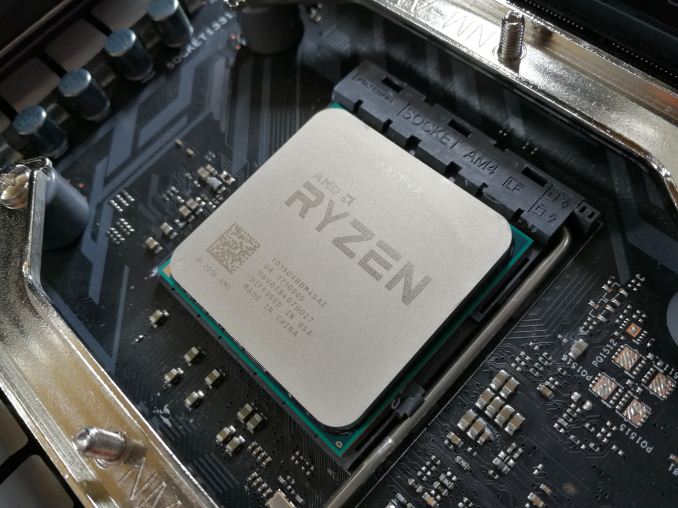 |
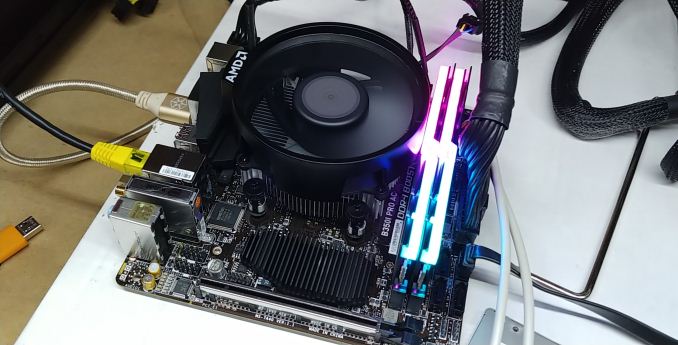 |
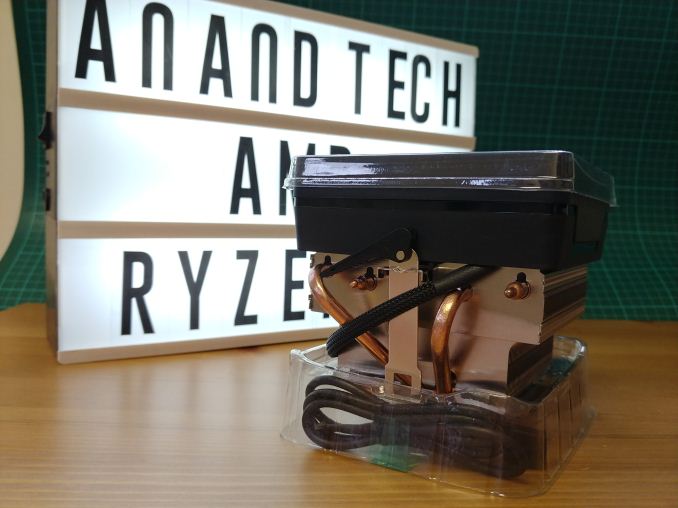 |
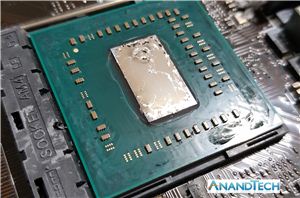 |
| Core Scaling | Memory Scaling | Graphics Scaling | Best CPUs |
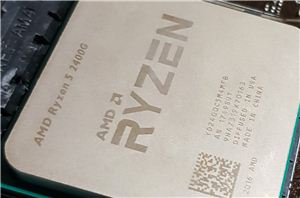 |
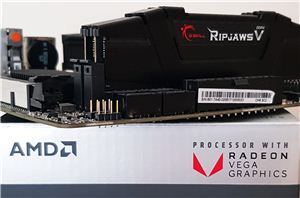 |
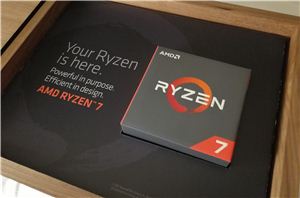 |
|


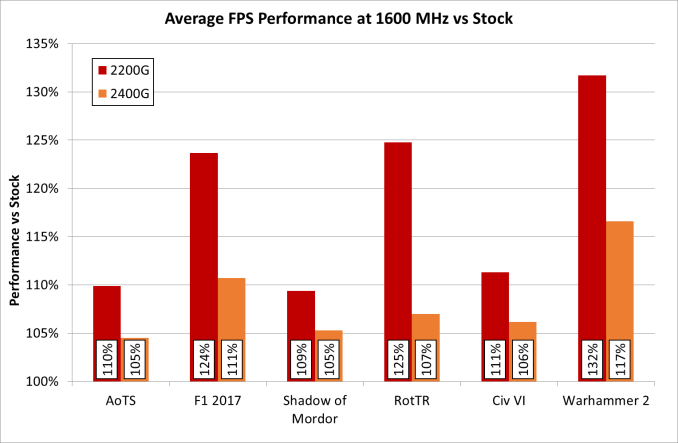
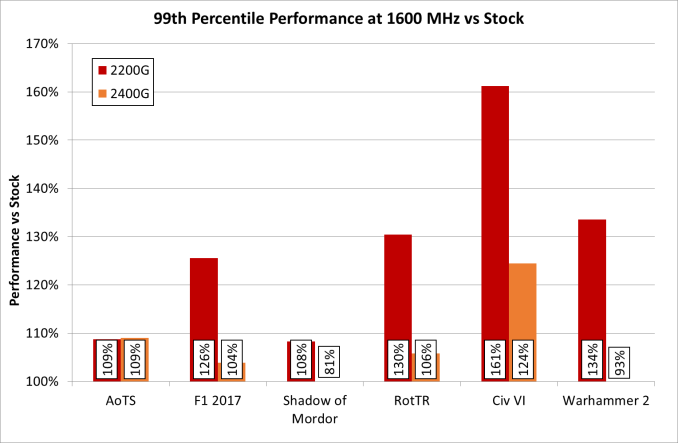
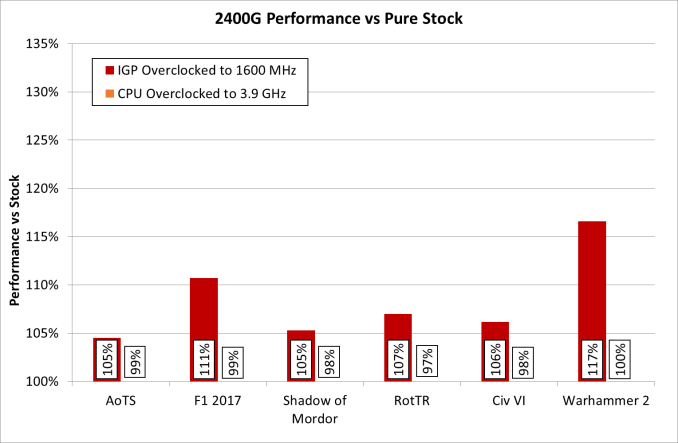

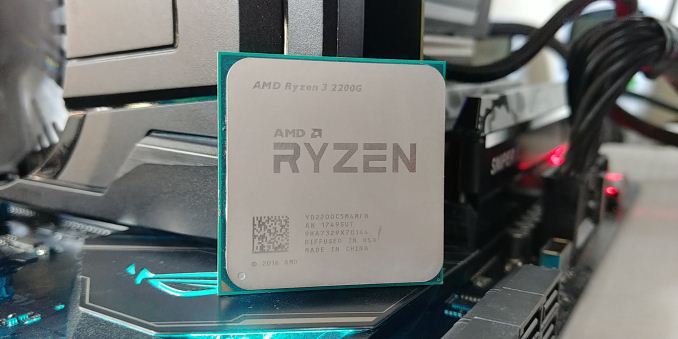








49 Comments
View All Comments
PeachNCream - Friday, September 28, 2018 - link
Interesting analysis, though it's a bit of a foregone conclusion these days to expect a GPU overclock to improve performance in games more than a CPU overclock since the central processor, after a point, has very little role in increasing framerates.This one struck me as odd though - "...Ryzen APUs are marketed for 720p gaming, and while resolutions such as 2160p and 1440p are out of reach purely for performance reasons, we have opted to use moderate settings at 1080p for our testing."
Were the tests executed at 1080p so they would align better in the Bench? It seems more reasonable to test at 720p given the various limits associated with iGPUs in general and the use of 1080p just comes across as lazy in the same way Anandtech tests CPU performance in games at resolutions so high that GPU performance masks the differences in various processors. Tom's Hardware, back when the good doctor actually ran it, yanked resolution down as low as possible to eliminate the GPU as a variable in CPU tests and it was a good thing.
stuffwhy - Friday, September 28, 2018 - link
Just purely speculating, is it possible that 720p results are just great (60+ fps) and need no testing? One could hope.gavbon - Friday, September 28, 2018 - link
My reasoning for selecting 1080p gaming tests over 720p was mainly because the other scaling pieces were running at the same resolution. Not just the iGPU tests, but the dGPU testing with the GTX 1060 too. It wasn't a case of being 'lazy' but the majority of gamers who currently use steam use 1080p and as it's the most popular resolution for gamers, I figured that's where I would lay it down.neblogai - Friday, September 28, 2018 - link
Even if monitor is 1080p, a lot of 2200G users may want to run games on 1080p with resolution scaling, for better fps. In effect, at 720p or 900p. Most games support it these days. So, popularity of 1080p monitors does not really make 720p tests less useful for this level of GPU performance.V900 - Friday, September 28, 2018 - link
Would be great if you had tested just one game at 720p.I know this is what I would be interested in knowing/reading if I was a possible customer.
usernametaken76 - Sunday, September 30, 2018 - link
I honestly think this "majority of gamers who currently use steam use 1080p" argument is affected by a) laptop users (see the high number of 1366x768 users) and therefore game at whatever resolution their laptop panel is set to...Which leads one to ask what the point of testing desktop parts is when you use that as a basis for what and how to test.
TheJian - Friday, October 5, 2018 - link
agree 100%. They do a lot of dumb testing here. Ryan has been claiming 1440p was the "enthusiast resolution" since Geforce 660ti. I don't even think you can say that TODAY as I'm staring at my two monitors (have a 3rd also 1080p), both of which are 1200p/1080p.For me, I need everything turned on, and you need to show where it hits 30fps at that level. Why? Because the designers of the games didn't want you to play their game at "MODERATE SETTINGS"...ROFL. Just ask them. They design EXACTLY WHAT THEY WANT YOU TO SEE. Then for some reason, reviewers ignore this, and benchmark the crap out of situations I'd avoid at all costs. I don't play a game until I can max it on one of my two monitors with my current card. If I want to play something that badly early, I'll buy a new card to do it. All tested resolutions should be MAXED OUT settings wise. Why would I even care how something runs being degraded? Show me the best, or drop dead. This is why I come to anandtech ONLY if I haven't had my fill from everywhere else.
One more point, they also turn cards etc, down. Run as sold, PERIOD. If it's an OC card, show it running with a simple checkbox that OC's it the max the card allows as their defaults. IE most have game mode, etc. Choose the fastest settings their software allows out of their usually 3 or 4 default settings. I'm not talking messing with OCing yourself, I mean their choses 3-4 they give in the software for defaults. Meaning a monkey could do this, so why pretend it isn't shipped to be used like this? What user comes home with an OC card and reverts to NV/AMD default ref card speeds? ROFL. Again, why I dropped this site for the most part. Would you test cars with 3 tires? Nope. They come with 4...LOL. I could go on, but you should get the point. Irrelevant tests are just that.
flyingpants265 - Tuesday, March 5, 2019 - link
Hate to tell you this, but 4k is the enthusiast resolution now.808Hilo - Saturday, October 13, 2018 - link
Is it just me or are these test just for borderline ill people?Playing 4k with a 1080/1800/32/S970. Works reasonably well. I also do everything else in 4k. Would I go back to lower res? No way. Artifical benchmarking is one, real world is 4k. Test this rez and we get a mixed GPU, APU, CPU bench. Build meaningful systems instead of artificially push single building blocks. Push for advancements. T
Targon - Friday, September 28, 2018 - link
The big problem with these APUs is that they limit the number of PCI Express channels, so if you DO decide to add a video card, the APU in this case will reduce performance, compared to a normal CPU without the graphics.